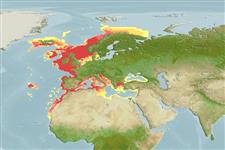Classification / Names
Common names from other countries
Main reference
Size / Weight / Age
Max length : 140 cm TL male/unsexed; (Ref. 1371); common length : 45.0 cm TL male/unsexed; (Ref. 1371); max. published weight: 15.0 kg (Ref. 1371); max. reported age: 20 years (Ref. 35388)
Length at first maturity
Lm 42.8, range 20 - 70 cm
Environment
Marine; demersal; depth range 30 - 1075 m (Ref. 58452), usually 70 - 400 m (Ref. 35388)
Climate / Range
Temperate, preferred 19°C (Ref. 107945); 76°N - 18°N, 30°W - 42°E (Ref. 58452)
Distribution
Eastern Atlantic: Norway and Iceland, southward to Mauritania. Also in the Mediterranean Sea and along the southern coast of the Black Sea.
Countries | FAO areas | Ecosystems | Occurrences | Introductions
Short description
Dorsal
spines
(total): 0;
Dorsal
soft rays
(total): 43-51;
Anal
soft rays: 36 - 40. Inside of mouth and branchial cavity black. Second dorsal and anal fins notched. First vertebra and neural spine attached to skull. Vertebrae 50-52.
IUCN Red List Status (Ref. 115185)
Threat to humans
Harmless
Human uses
Fisheries: highly commercial
More information
ReferencesAquacultureAquaculture profileStrainsGeneticsAllele frequenciesHeritabilityDiseasesProcessingMass conversion
Tools
Special reports
Download XML
Internet sources
Estimates of some properties based on models
Phylogenetic diversity index
PD50 = 0.5000 many relatives (e.g. carps) 0.5 - 2.0 few relatives (e.g. lungfishes)
Trophic Level
4.4 ±0.0 se; Based on diet studies.
Resilience
Medium, minimum population doubling time 1.4 - 4.4 years (K=0.07-0.3; tmax=20; Fecundity=7 million)
Vulnerability
High vulnerability (64 of 100)
Price category
